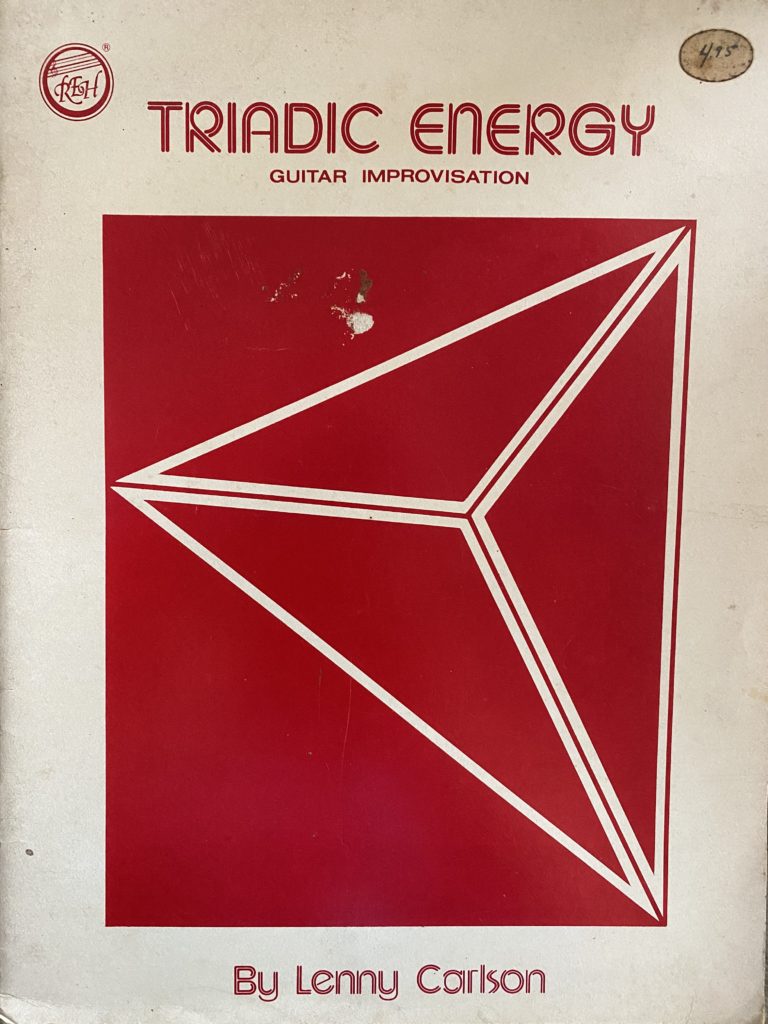
This book published by REH back in 1978 is an interesting document of polytonal thinking. Essentially, it gives ideas for melodic improvisation that go “outside” using a simple concept based around the diatonic triad. There’s also use of octave displacement & mixing inversions of the major triad to create a less obvious pattern in the chromatic lines demonstrated.
This reminds me of a few things I’ve seen:
1) Saxophonist George Garzone’s Triadic Chromatic Approach (which I haven’t studied too in depth, although I’ve explored it off and on over the years)
2) Guitarist Pat Martino’s 12 Chromatic Forms for Guitar (available on Dan Alder’s website here and also more examples are in Pat Martino’s Truefire course)
The interesting thing about Lenny’s book is that this was published back in 1978 and is a relatively earlier example of this kind of thinking documented in print.
At 24 pages, it is a slim book… but the content is deep and requires dedication to be internalized. That’s one thing that I’ve learned over the years… to not judge the value of a book based on the number of pages. Some things can be more useful when concisely explained… and others may require hundreds of pages or volumes of books to be clearly explained.
You also have the chance to not be overwhelmed with the sheer volume of information in a shorter book.
All in all, this book is a cool resource for someone is interested to develop chromatic playing in a guitaristic way, systematically using a simple concept. Personally, I got a lot even after my first reading of the entire book, and I do plan to study the examples in more depth gradually.
If you can find a copy of this book at a reasonable price, do get it if you’re into different ways of playing/improvising chromatically. Just remember that because the book doesn’t come with any tablature or CD/cassette/audio recording, you will have to read everything and also record yourself to hear how these melodies work over chord progressions.
In other words, some assembly required!
Pros: Good book with cool examples. Fretboard diagrams and explanations are clear and helpful.
Cons: Implementing this into one’s playing will require A LOT of work.
TLDR: Love chromatic playing? Want to discover one way to create chromatic lines? You might like this book.
How to Buy:
If you’re interested to get a copy of this book, you can try to look for this book on Amazon, eBay or AbeBooks. It’s out of print, so it can be difficult to find a copy.
Good luck!
[Review Archive]
I wrote a lot of other book, course and video reviews too.
Check out the rest here:
[Read more reviews]
[Submissions for Review Consideration]
- Are you an author who wrote a jazz, guitar or music book?
- Have you created a DVD or an online video course or subscription based website?
- Would you like me to review your book/course?
Please send me a message at azsamad3 at gmail.com with:
For courses: a link to the course/video/product + access info etc.
For books: a link to the book (Dropbox) or PDF attachment (if it’s small) for review consideration.
Depending on whether I dig the book/course, I’ll let you know if I do plan to review it!
I cannot guarantee a review for every submission & if I’m not too into it, I may opt not to review it. I mean, it’s better to get a good review that for me to write a bad review just because it’s not a match for the kind of stuff I dig right? :p
NOTE: All reviews reflect my honest personal opinion so be aware that I will point out both cool Pros and Cons that I see in the work. You dig?
Leave a Reply